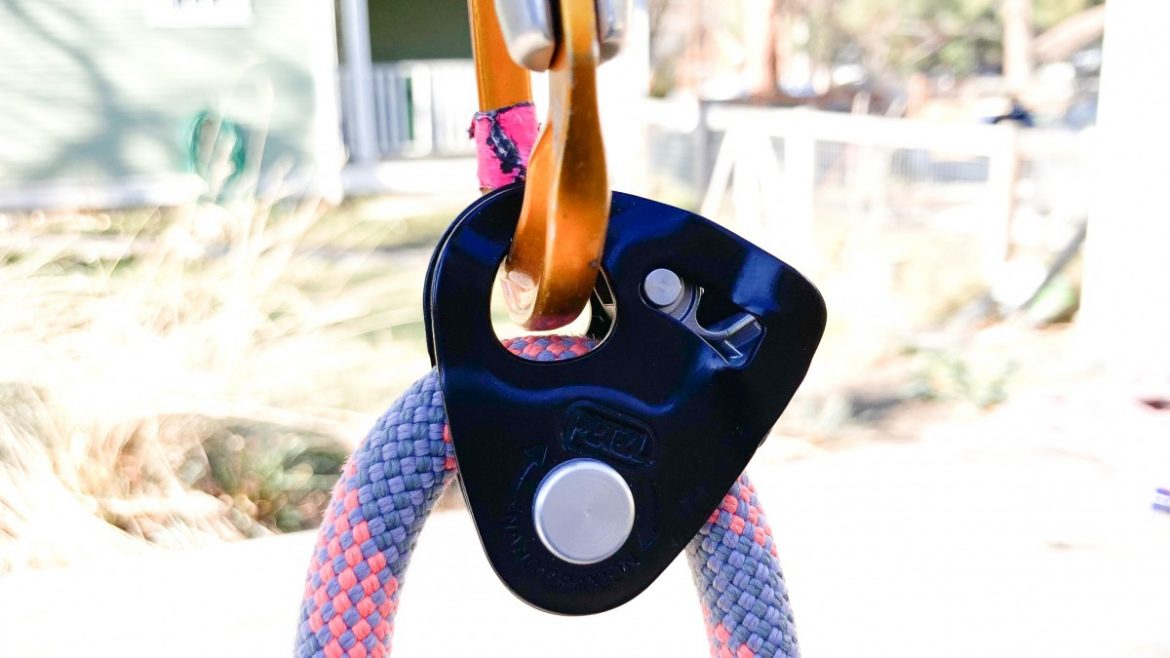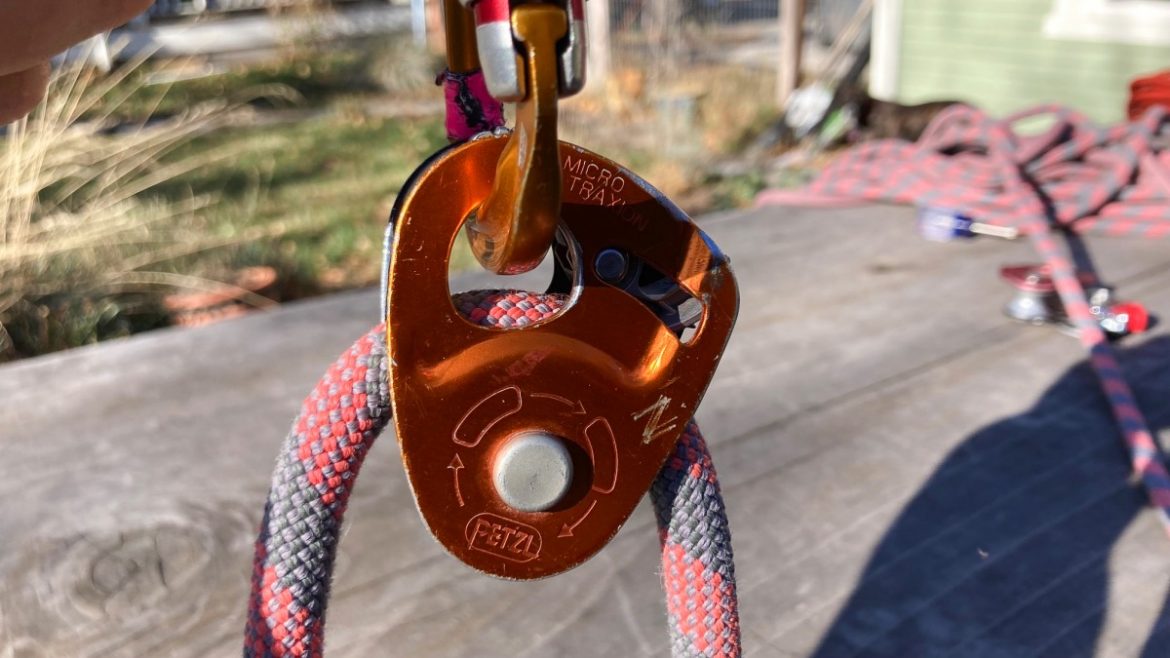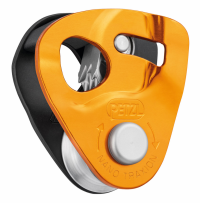
The Petzl Nano Traxion in its orange-gold hue is a capable, yet light, progress capture device. Photo: Petzl
Lighter is better to a point. Over the decades, material science and designers have almost normalized what we once thought was Frankensteined. But weight reduction, for example, has its limitations. So when word leaked mid-pandemic that engineers at Petzl were once again shrinking-the-Traxion, there were some head pivots.
A few weeks back, Petzl released their latest iteration of progress-capture-pulley in the Traxion series: the Nano Traxion.
First, let’s back up if you are new to the term progress-capture. Think older school – and an ascender (Jumar) to ascend a rope. The ascender is pushed up the rope, and a spring-loaded cam with teeth bites into the rope and cams tight as one adds body weight. With a proper setup, the climber goes up the rope and does not slide back down. The ascender captures the climber’s progress as they move up.
Petzl Traxion devices use the same premise. However, they have a built-in pulley for use in hauling systems, like crevasse rescue. With a Traxion employed on the ropes, you can haul up on the load and then release the rope, with the load’s progress, or advances, captured. The pulley helps reduce friction in the system. The Traxions can be used, too, to ascend a rope; it’s an excellent tool for improvised rope ascension vastly outperforming a traditional prusik or other friction hitches.
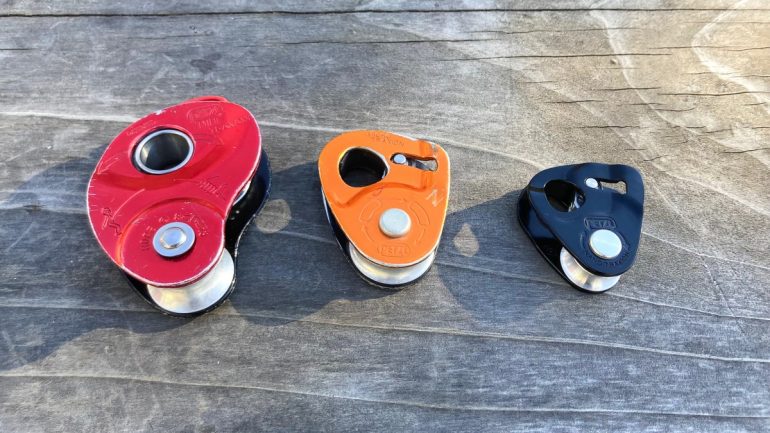
From left to right: The Mini Traxion, Micro Traxion, and newly released Nano Traxion.
The Lineage: Mini to Micro to Nano
Some readers might recall the red Mini Traxion. What may have appeared mini years ago, is now Clydesdale. This piece of discontinued equipment weighs 172g and was primarily employed to haul loads up a wall or in a top rope solo (TRS) system. My experience with the Mini is from TRS, where I still use two Minis, one of which serves as a backup, to protect a fall while top-roping. I also have carried a Mini to assist in the event of a crevasse rescue while on glaciers. It’s big and clunky for that, but serves the purpose of a high functioning ratchet when setting up a rescue system.
Around 2012, Petzl unveiled the Micro Traxion. If you follow the nomenclature, micro is smaller than mini. And in this instance, more refined. The Micro weighs a verified 80g, nearly halving the weight penalty of carrying a Mini, with no performance penalty. Micros have been widely adopted as critical gear for fast and effective crevasse rescue. The cam on the Micro is easily locked open if one desires to use the device as a pulley only.
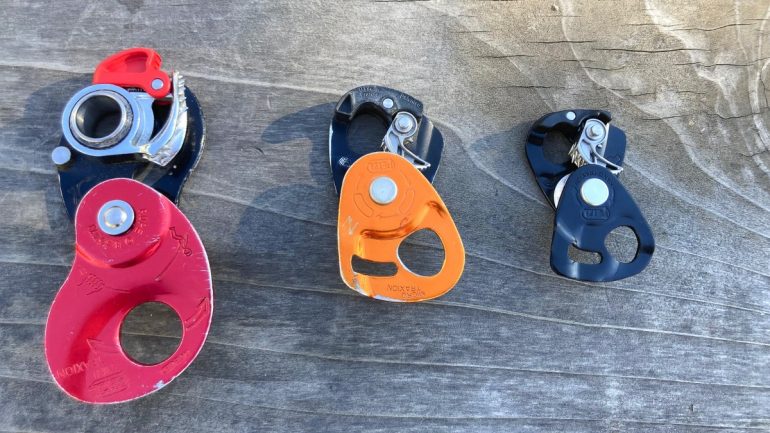
The three Traxions opened wide. The red Mini is discontinued.
With the release of the Nano – nano items are smaller still – Petzl reduced the overall weight and size again. Flyweight at 52g, you can fit two Nanos side by side in your palm. The key difference with the Micro, beyond size and weight; there’s no cam lock-out function. However, this reduced version of Traxion is fully functional as a progress capture pulley and ascending device, just not a stand-alone pulley.
Petzl states both the Micro and Nano pulleys work at 91% efficiency when used as a ratchet. This number refers to how “efficiently” the pulley itself rotates under load as a pulley, not a ratchet. (Both are ball bearing pulleys.) According to AMGA/IFMGA guide Ian Nicholson; while both these pulleys have a 91% efficiency for their pulley, the sheave, or pulley with a groove, on the Nano is smaller, with a diameter of 15mm compared to the Micro’s 20mm. In-general larger diameter pulleys equate to greater overall efficiency when moving loads. However, in this case, the 5mm difference is pretty small, and even the most tech-savvy WildSnow reader is unlikely to notice it, nor is it likely to make a noticeable difference in a real-world rescue situation.
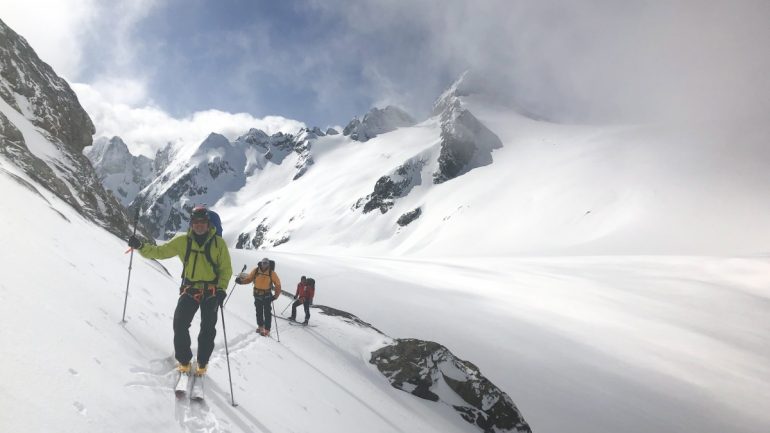
Skiers Nate Helweg, Doug Poortenga, and Ken Boggs having just crossed the Neve Glacier on the final day of the Isolation Traverse in the North Cascades. This is Traxion terrain. Photo: Ian Nicholson.
For those concerned with the Nano‘s inability to be used as a stand-alone pulley, Nicholson says, “whether people realize it or not, people use and are taught to use these tools for their ratchet capabilities rather than their ability to reduce friction”.
Nicholson explains the vast majority of users will use the Nano or the Micro in their hauling systems where it captures rope progress rather than where it will reduce the most friction.
“This is because most people choose to use their Traxion at the bend in the rope closest to the ‘load end’ (where it works best as a ratchet/rope capture) rather than position it in the final bend closest to the hauler, where it would reduce the most friction (as friction reduced closest to the hauler is experiential through the system),” added Nicholson. “Placing the pulley closest to the load is the best place for a ratchet but is the least efficient place for reducing rope drag.”
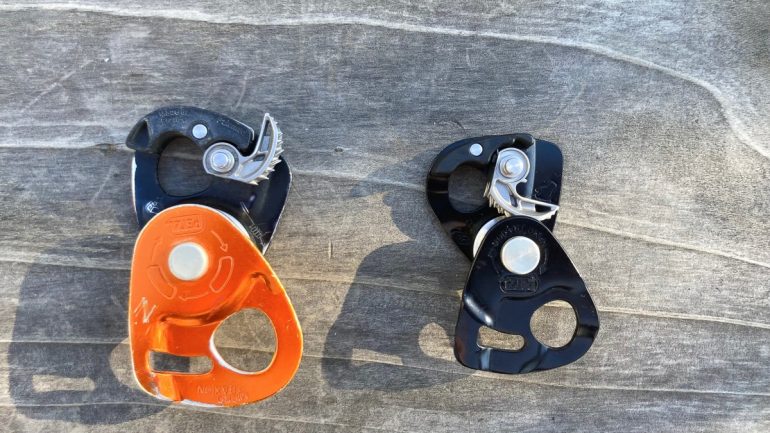
The Micro on the right with its cam locked out. The Nano’s cam cannot be locked out – it cannot be used as a stand alone pulley.
The Nano’s smaller sheave is even less of concern since the rope diameters used in skiing and crevasse rescue are generally skinnier than those for rock climbing or rope access, for which these devices are also designed. A typical dynamic rope used for glacier travel and skiing runs near 7.5-8mm in diameter. In contrast, newer hyperstatic ropes like the Petzl RAD Line and Mammut Glacier Cord are more floss-like at 6mm in diameter. Increased friction when hauling with these skinnier ropes is less of a concern. (Warning -hyperstatic ropes should not be used for lead climbing or any climbing with a “fixed belay”!! At least this is what Petzl recommends.)
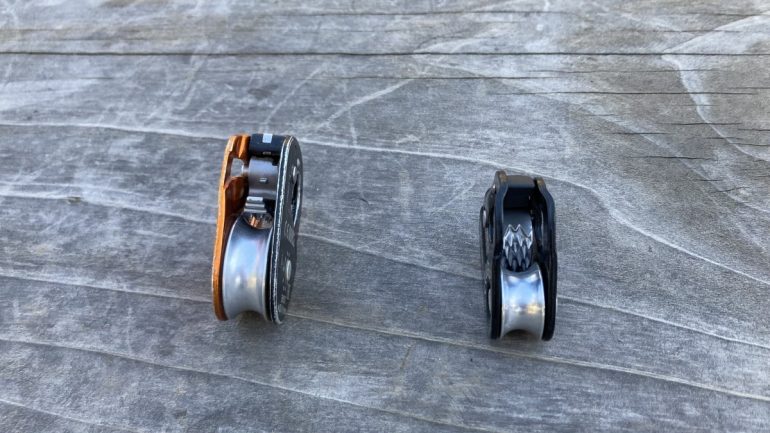
A thin side look of the Micro and Nano with the sheave size slightly larger on the Micro.
Rope compatibility is another consideration. Petzl’s documentation, and it’s also printed on the Traxion devices, claims safe functionality of ropes between 8-11mm for the Micro, and 7-11mm for the Nano. Petzl has also published documentation about the safe use of the Micro with the RAD Line due to its specialized textured sheath, same for the PUR Line. Although Petzl has not updated their website regarding the RAD Line and compatibility with the Nano, that documentation is forthcoming and should confirm compatibility.
The trend in most rope use disciplines has evolved towards skinnier. But still, you might find yourself using a thicker rope in conjunction with a Micro and Nano. Running a 10.5mm dynamic rope through the Micro and Nano and hauling an 80lb piece of concrete off a tree limb yields no discernible sensations. I noticed no more friction using the Nano compared to the Micro despite the Nano’s smaller pulley. (This was not a lab-test situation, this was perceived effort, newtons exerted and friction incurred were not measured.)
The same was true hauling with a RAD Line; no perceptible difference in friction. That may change in the field during real-world scenarios where other causes of friction come into play.
Another difference is the smaller carabiner hole on the Nano than the Micro. However, despite its smaller size, I had no problems fitting a large Pezlt William locking carabiner through the Nano’s hole. It is foreseeable that with a large carabiner and a larger diameter rope than the 10.5mm I tested with, the Nano’s smaller opening, which allows for less space between the carabiner and rope when under load, may add friction to the system.
Speaking of carabiners and the Nano, this is a small device, and losing it to gravity’s pull is plausible. Petzl recommends using its Sm’D locking biner in conjunction with the Nano; a small hole is drilled into the Sm’D, allowing for a thin tether cord to be attached, linking the Nano and the Sm’D. Petzl says this once you have the Nano tethered to a Sm’D: it makes “the device loss proof”. As a pro-level fumbler in some situations, the added security of the tether is a good idea, as you are less likely to drop this small unit.
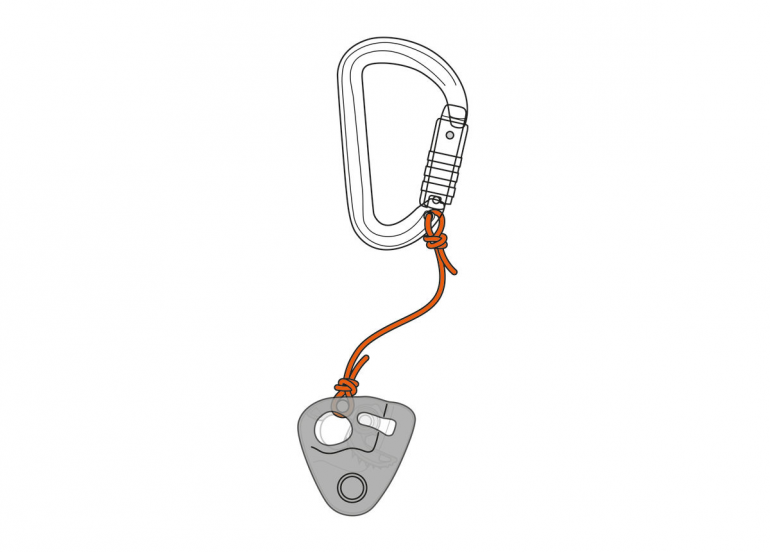
Petzl’s drawing of a Nano connected to a Sm’D locking biner.
Some might say progress capture pulleys like the Nano or Micro are luxuries. It is true, establishing hauling systems and ascending systems with prusik knots or klemheists and a pulley or two are time-tested. Like most things, you’ll have to make a personal choice regarding your glacier travel or skiing setup. But using a device like the Nano and the Micro makes establishing the rescue or ascension system of choice easier to deploy, which might make a difference in a dicey situation. And the Micro and Nano will grab on icy ropes.
Nicholson says, “I think the Nano or Micro is an invaluable tool for crevasse rescue because it is so much more straightforward and requires less ‘tending’ than an improvised system.”
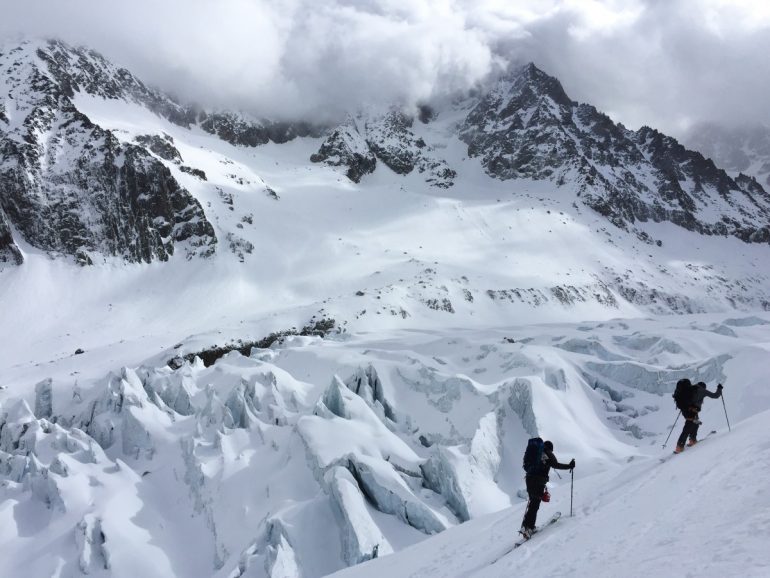
Quick access to simple and effective rescue systems are a must in glaciated terrain. Photo: Ian Nicholson.
I’m more apt to bring gear along when it is practical and light. There’s little cost to throwing a 30m 7.8mm rope in a backpack and wearing a minimalist harness if I need them. I have loved the simplicity of my outdated Mini Traxion, but the Nano and its diminutive specs and goliath functions are supremely welcome. If you have the money, what’s another 52g?
The Nano Traxion costs $99.95.
We tested a black version of the Nano from Petzl’s tactical line – an identical product is available from their sport’s line; it, however, comes in a shiny orange/gold color.
We’ll have more later this winter, or more likely spring, when we incorporate this into a functional crevasse rescue simulation.
Jason Albert comes to WildSnow from Bend, Oregon. After growing up on the East Coast, he migrated from Montana to Colorado and settled in Oregon. Simple pleasures are quiet and long days touring. His gray hair might stem from his first Grand Traverse in 2000 when rented leather boots and 210cm skis were not the speed weapons he had hoped for. Jason survived the transition from free-heel kool-aid drinker to faster and lighter (think AT), and safer, are better.

